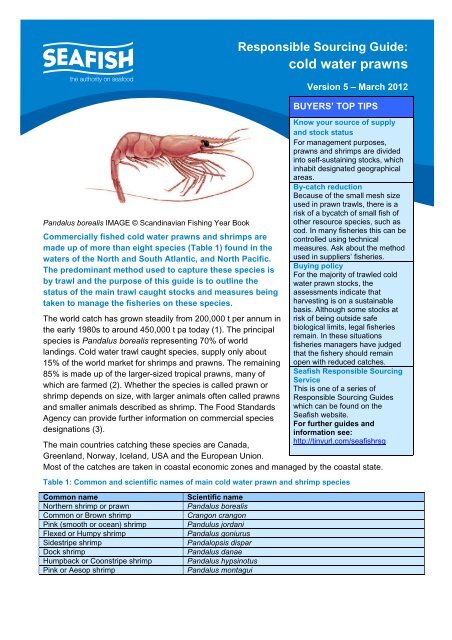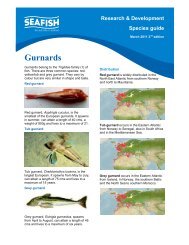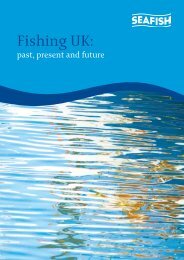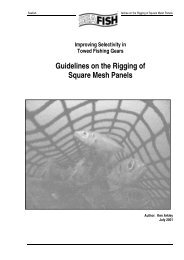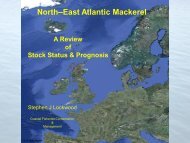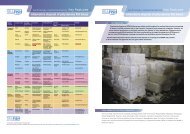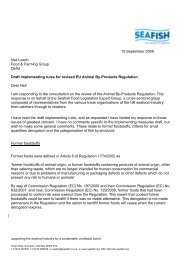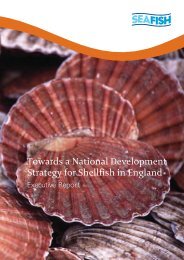Create successful ePaper yourself
Turn your PDF publications into a flip-book with our unique Google optimized e-Paper software.
Pandalus borealis IMAGE © Scandinavian Fishing Year Book<br />
Commercially fished cold <strong>water</strong> <strong>prawns</strong> and shrimps are<br />
made up of more than eight species (Table 1) found in the<br />
<strong>water</strong>s of the North and South Atlantic, and North Pacific.<br />
The predominant method used to capture these species is<br />
by trawl and the purpose of this guide is to outline the<br />
status of the main trawl caught stocks and measures being<br />
taken to manage the fisheries on these species.<br />
The world catch has grown steadily from 200,000 t per annum in<br />
the early 1980s to around 450,000 t pa today (1). The principal<br />
species is Pandalus borealis representing 70% of world<br />
landings. <strong>Cold</strong> <strong>water</strong> trawl caught species, supply only about<br />
15% of the world market for shrimps and <strong>prawns</strong>. The remaining<br />
85% is made up of the larger-sized tropical <strong>prawns</strong>, many of<br />
which are farmed (2). Whether the species is called prawn or<br />
shrimp depends on size, with larger animals often called <strong>prawns</strong><br />
and smaller animals described as shrimp. The Food Standards<br />
Agency can provide further information on commercial species<br />
designations (3).<br />
Responsible Sourcing Guide:<br />
cold <strong>water</strong> <strong>prawns</strong><br />
Version 5 – March <strong>2012</strong><br />
BUYERS’ TOP TIPS<br />
Know your source of supply<br />
and stock status<br />
For management purposes,<br />
<strong>prawns</strong> and shrimps are divided<br />
into self-sustaining stocks, which<br />
inhabit designated geographical<br />
areas.<br />
By-catch reduction<br />
Because of the small mesh size<br />
used in prawn trawls, there is a<br />
risk of a bycatch of small fish of<br />
other resource species, such as<br />
cod. In many fisheries this can be<br />
controlled using technical<br />
measures. Ask about the method<br />
used in suppliers’ fisheries.<br />
Buying policy<br />
For the majority of trawled cold<br />
<strong>water</strong> prawn stocks, the<br />
assessments indicate that<br />
harvesting is on a sustainable<br />
basis. Although some stocks at<br />
risk of being outside safe<br />
biological limits, legal fisheries<br />
remain. In these situations<br />
fisheries managers have judged<br />
that the fishery should remain<br />
open with reduced catches.<br />
<strong>Seafish</strong> Responsible Sourcing<br />
Service<br />
This is one of a series of<br />
Responsible Sourcing Guides<br />
which can be found on the<br />
<strong>Seafish</strong> website.<br />
For further guides and<br />
information see:<br />
http://tinyurl.com/seafishrsg<br />
The main countries catching these species are Canada,<br />
Greenland, Norway, Iceland, USA and the European Union.<br />
Most of the catches are taken in coastal economic zones and managed by the coastal state.<br />
Table 1: Common and scientific names of main cold <strong>water</strong> prawn and shrimp species<br />
Common name<br />
Northern shrimp or prawn<br />
Common or Brown shrimp<br />
Pink (smooth or ocean) shrimp<br />
Flexed or Humpy shrimp<br />
Sidestripe shrimp<br />
Dock shrimp<br />
Humpback or Coonstripe shrimp<br />
Pink or Aesop shrimp<br />
Scientific name<br />
Pandalus borealis<br />
Crangon crangon<br />
Pandulus jordani<br />
Pandalus goniurus<br />
Pandalopsis dispar<br />
Pandalus danae<br />
Pandalus hypsinotus<br />
Pandalus montagui
2 Responsible Sourcing Guide: <strong>Cold</strong> <strong>water</strong> <strong>prawns</strong>. Version 5 – March <strong>2012</strong><br />
Status of cold<strong>water</strong> prawn stocks March <strong>2012</strong><br />
Prawn fisheries<br />
Prawns are found at depths<br />
ranging from the low <strong>water</strong><br />
mark to 1330m, with the<br />
majority harvested at 100m to<br />
700m depth. Bottom trawls are<br />
the most common fishing<br />
gear.<br />
Biology<br />
The maximum size of<br />
Pandalus borealis is variable,<br />
depending on <strong>water</strong><br />
temperature. They can live to<br />
eight years or more and can<br />
reach 36mm carapace length.<br />
However, the common<br />
harvesting size is 24-30mm<br />
carapace length.<br />
After a two to three month free<br />
swimming phase, <strong>prawns</strong> start<br />
their life as sexually immature<br />
juveniles, developing into<br />
males. As the males grow old<br />
they undergo a sex change<br />
and become females. Since<br />
females are older and larger<br />
than males, care must be<br />
taken not to catch all or most<br />
of the females and thus<br />
overexploit the fishery. Most<br />
species spawn once or twice<br />
as females. After spawning<br />
they are vulnerable and<br />
unlikely to survive beyond<br />
their second spawning.<br />
Assessments<br />
Surveys and commercial catch<br />
rates and effort are used to<br />
assess changes in biomass.<br />
Research trawl surveys report<br />
similar recruitment over a fairly<br />
large areas, thus widespread<br />
environmental conditions are important in recruitment of young<br />
animals. The status of predator populations such as cod, is an<br />
important factor in the assessment and is increasingly included in the<br />
modelling of sustainable catch levels.<br />
Maximum Sustainable Yield and Precautionary Approach<br />
Maximum Sustainable Yield (MSY) relates to optimising exploitation<br />
to obtain the best long term yields. At high biomasses the stock is<br />
likely to grow slowly, as the biomass decreases the growth and hence<br />
yield increases the maximum is at MSY. If the quantity of female<br />
<strong>prawns</strong> removed from the stock is too high the stock cannot<br />
reproduce enough to be able to sustain a fishery; it is described as<br />
being outside safe biological limits, shown in red on Figure 1.<br />
Figure 1: Relationship between prawn stock biomass and MSY.<br />
Green indicates inside safe biological limits, yellow at risk and<br />
red outside safe biological limits and relates Stocks are colour<br />
coded according to status on Table 2 and the map (Figure 4)<br />
Figure 3 Relationship between mortality and MSY; if mortality<br />
due to fishing and predation exceeds MSY, then TACs should be<br />
reduced to ensure maximum yields. If the mortality is below than<br />
which would enable MSY then catches can be increased. Fishing<br />
mortality in relation to safe biological limits is only defined for a<br />
limited number of stocks so stocks are not colour coded in<br />
relation to mortality on Table 2 and the map Figure 4
3 Responsible Sourcing Guide: <strong>Cold</strong> <strong>water</strong> <strong>prawns</strong>. Version 5 – March <strong>2012</strong><br />
Table 2:<br />
Management<br />
Stock<br />
Catch<br />
(tonnes)<br />
Year as<br />
indicated<br />
(1)<br />
Advisory<br />
TAC<br />
(tonnes)<br />
Scientific advice and management<br />
NORTH ATLANTIC PRAWN STOCKS (Pandalus borealis and other Pandalus sp)<br />
Inside safe biological limits<br />
Barents Sea:<br />
ICES I & II<br />
23,000<br />
(2011)<br />
60,000<br />
(<strong>2012</strong>)<br />
East Greenland<br />
ICES Div XIVb<br />
and Va<br />
East Canada and<br />
West Greenland –<br />
international<br />
<strong>water</strong>s<br />
NAFO 0 and 1<br />
Canadian Atlantic<br />
EEZ; Shrimp<br />
Fishery Areas<br />
(SFAs) 0,2<br />
(P.borealis only in<br />
SFA 2), 4, 5, 8-12<br />
1,084<br />
(2011)<br />
128,000<br />
(2011)<br />
Total<br />
Atlantic<br />
Canada<br />
EEZ=<br />
164,218<br />
(2010)<br />
12,400<br />
(<strong>2012</strong>)<br />
90,000<br />
(<strong>2012</strong>)<br />
Most<br />
recent<br />
advised<br />
TAC=<br />
0,2,4,5,<br />
8-12<br />
92,735<br />
At risk of being outside safe biological limits<br />
Nov 2011. This stock is in good condition inside safe biological<br />
limits and fished at below Maximum Sustainable Yield. The<br />
recommended TAC has a less than 1% risk of fishing mortality<br />
exceeding maximum sustainable yield or causing detrimental<br />
effects on the biomass. Recruitment indices declined from 2004<br />
to 2008, but has since been higher (4)<br />
Oct 2011. Since 2008, annual assessments of the stock<br />
biomass has taken place. Stock densities were highest in the<br />
region north of 65 o N. The biomass of shrimp in 2011 is<br />
estimated to be at a relatively high level and to have been there<br />
since 1998. The catch per unit effort was stable at a relatively<br />
high level during the period 2000 - 2009; in 2010 and 2011 it is<br />
back to a level seen at the beginning of 2000. The overall catch<br />
has decreased which may be related to economic viability (4).<br />
Oct 2011 Catch per unit effort data has generally been used to<br />
give an index of the biomass densities available to the fishery,<br />
supported by bottom trawl surveys since 1988. The record high<br />
biomass in 2003 was followed by decline to 2011. Although the<br />
biomass is above BMSY (Figure 1), the rate of mortality caused<br />
by fishing and predation has been above that which would yield<br />
MSY since 2005 (4); see Figure 2. Cod predation is considered<br />
to be an important factor<br />
Feb <strong>2012</strong> There are 15 shrimp fishery areas in the Canadian<br />
Atlantic ranging from SFA 0 in the Arctic to SFA 15 south of<br />
Nova Scotia, each with its own TAC. The TACs for two of these<br />
fishing areas (SFAs 1 and 7) are agreed jointly with NAFO (Div<br />
0a (see above) and Div 3L (see bellow)) based on shared<br />
research SFA0 (west of NAFO 0a) and SFAs 2-15 are agreed<br />
unilaterally. The basis for the TACs is catch per unit effort and<br />
spawning stock biomass assessment. Rises of sea temperature<br />
have a yet unknown effect. Overall the fisheries in these areas<br />
are inside precautionary limits. Some of the fisheries have MSC<br />
certification (16)<br />
NAFO 3L, 3N, 3O<br />
SFA 7 for<br />
Canadian<br />
11,000<br />
(2011)<br />
12,000<br />
(<strong>2012</strong>)<br />
Oct 2011. Catch effort and biomass survey data are available.<br />
Fishing has been restricted to Div 3L. The stock has declined<br />
since 2007 and the female biomass at the end of 2011 is<br />
predicted to be close to the minimum limit. The decreased levels<br />
of biomass call for caution in setting future TACs (4).
4 Responsible Sourcing Guide: <strong>Cold</strong> <strong>water</strong> <strong>prawns</strong>. Version 5 – March <strong>2012</strong><br />
Table 2:<br />
Management<br />
Stock<br />
Catch<br />
(tonnes)<br />
Year as<br />
indicated<br />
(1)<br />
Advisory<br />
TAC<br />
(tonnes)<br />
Scientific advice and management<br />
Canadian Atlantic<br />
EEZ SFA 2<br />
(Pandalus<br />
montagui only in<br />
2) 3, 6 and 13-15<br />
See above<br />
for total<br />
Atlantic<br />
Canada<br />
EEZ<br />
Total<br />
Most<br />
recent<br />
advised<br />
TAC<br />
2,3,6<br />
and 13-<br />
15<br />
61,687<br />
June 2011 SFA 2 Pandalus montagui only; distributional shift<br />
likely because of an increase in <strong>water</strong> temperature. Spawning<br />
stock biomass declining and inside precautionary zone.<br />
Sept 2011 SFA 6 Female spawning stock biomass assessed<br />
declining and inside the precautionary zone<br />
Feb <strong>2012</strong> SFA 13-15 Biomass downturn, decrease in shrimp<br />
size, unfavourable ecosystem indicators and a shift in fishing<br />
effort indicate a requirement for precaution to prevent the stock<br />
being at risk.<br />
US Atlantic<br />
States EEZ<br />
5,944<br />
(2011)<br />
Iceland EEZ 7,741<br />
(Sept 2011-<br />
August<br />
<strong>2012</strong>)<br />
Outside safe biological limits<br />
NAFO 3M 0<br />
(2011)<br />
Reference points not defined<br />
Barents Sea: 675<br />
Russian Fed EEZ (2010)<br />
S. Norway and 3,058<br />
Skagerrak ICES<br />
IIIa and IVa (west) (2010)<br />
Fladen Ground<br />
Farne Deeps<br />
ICES IVa<br />
0<br />
(since<br />
2006)<br />
2,211<br />
(<strong>2012</strong>)<br />
7,850<br />
(Sept<br />
2011/Au<br />
gust<br />
<strong>2012</strong>)<br />
0<br />
(<strong>2012</strong>)<br />
na<br />
Less<br />
than<br />
8,300<br />
(<strong>2012</strong>)<br />
0<br />
(<strong>2012</strong>)<br />
Oct 2011. Early Season closures occurred in 2010 and 2011<br />
because landings were greater than anticipated. Untimely<br />
reporting resulted in overharvesting of TAC by 28% and 48%<br />
respectively in these two years. Currently the stock is<br />
overfished with fishing mortality estimated at above the target,<br />
and biomass is estimated at only 72% of the target. Future<br />
management allows options to slow catch rate throughout the<br />
season (7).<br />
Aug 2011 Scientific recommendations and TACs are based on<br />
the assessment of different stocks. Most of the inshore stocks<br />
have collapsed in recent years due to predation by cod. As a<br />
result the inshore fishery has been closed with minor<br />
exceptions. The offshore stocks have also declined considerably<br />
since 1997 due to increased cod predation (8).<br />
Oct 2011. Catch effort and survey data are available. The 2011<br />
survey biomass index indicates that the stock is below minimum<br />
limit. Recommends that fishing for 2013 be set as close to zero<br />
as possible. It is noted that factors other than fishery may be<br />
involved in the current decline of the stock (4)<br />
Catch is principally Humpy or Coonstripe shrimp. Status of<br />
stocks are unknown<br />
Nov 2011. Survey biomass indices have declined since 2007.<br />
Recruitment indices have also declined since 2006, although<br />
2011 saw an increase, but numerically still low. Natural<br />
mortality due to predators is probably substantially higher than<br />
fishing mortality. The main regulatory measure is a TAC, which<br />
is not fully utilised by all countries participating in the fishery (9).<br />
Nov 2011. The available information is inadequate to evaluate<br />
stock trends. Management advice is that no catch should take<br />
place unless there is evidence that this will be sustainable (9).
5 Responsible Sourcing Guide: <strong>Cold</strong> <strong>water</strong> <strong>prawns</strong>. Version 5 – March <strong>2012</strong><br />
Table 2:<br />
Management<br />
Stock<br />
Catch<br />
(tonnes)<br />
Year as<br />
indicated<br />
(1)<br />
Advisory<br />
TAC<br />
(tonnes)<br />
Scientific advice and management<br />
Canadian EEZ<br />
SFA 3<br />
4,700 Limited data means that prospects are uncertain<br />
Brown shrimp :<br />
(Crangon<br />
crangon) N. Sea<br />
ICES IVb, IVc<br />
36,000<br />
(2010)<br />
na<br />
May 2011. No TAC is set ,but the fishery is subject to national<br />
control within territorial <strong>water</strong>s. An ICES working group meets<br />
annually (10).<br />
NORTH WEST PACIFIC PRAWN STOCKS (Pandalus borealis and other species)<br />
Russian<br />
9,740 na Stock status not known.<br />
Federation EEZ (2010)<br />
NORTH EAST PACIFIC PRAWN STOCKS (P. jordani, P. hypersinotus, Pandalopsis dispar)<br />
Canadian Pacific<br />
EEZ<br />
640<br />
(2009/10)<br />
US Pacific EEZ<br />
Pandalus jordani<br />
20,318<br />
(2010)<br />
3,674<br />
(2010/1<br />
1)<br />
No TAC<br />
set<br />
At risk of being outside safe biological limits<br />
Bering Sea,<br />
Aleutian Islands,<br />
Gulf of Alaska<br />
880 (av<br />
2000-<br />
2005)<br />
No TAC<br />
set<br />
March <strong>2012</strong>.Catch ceilings are defined for 15 fishing zones<br />
using reference points linked to indices of stock biomass based<br />
on fishery trawl surveys. Harvesting rates are defined according<br />
to whether the biomass is in the critical, cautious or healthy<br />
levels. Overall the recent shrimp catches have been well below<br />
TACs set, mainly due to poor market conditions (12)<br />
The fishery is taken off the coast of California, Oregon and<br />
Washington State. Management is passive, based on a fixed<br />
season (April to October), Regulations are based on net mesh<br />
size, average size of individuals caught, and restrictions on bycatch.<br />
(11) The Oregon fishery is MSC certified (16)<br />
Dec 2011. The populations of shrimp declined due to climatic<br />
changes in the early 1980s. Changes in populations continue to<br />
occur due to changes in predation. The fishery is constrained by<br />
number of licences and catch capping (13).
6 Responsible Sourcing Guide: <strong>Cold</strong> <strong>water</strong> <strong>prawns</strong>. Version 5 – March <strong>2012</strong><br />
Figure 4: Map of North Atlantic prawn stock locations (colour keyed to table)<br />
Organisation key<br />
ICES: International Council for<br />
Exploration of the Sea; the<br />
international body responsible<br />
for stock assessment in the<br />
North East Atlantic. It advises<br />
international fisheries<br />
management organisations<br />
such as the Joint Russian<br />
Norwegian Commission on<br />
Fishing (JRNC), and the<br />
European Union (EU) where<br />
appropriate.<br />
NAFO: Northwest Atlantic<br />
Fisheries Organisation, the<br />
intergovernmental<br />
organisation responsible for<br />
science and management in<br />
the North West Atlantic<br />
International Waters.<br />
Key;<br />
Inside safe biological<br />
limits<br />
At risk of being<br />
outside safe<br />
biological limits<br />
Outside safe<br />
biological limits<br />
Management and conservation measures<br />
An important environmental effect of trawling for cold <strong>water</strong> <strong>prawns</strong> and shrimp is the potential for by-catch of<br />
undersized fish of other species. Fisheries’ managers can approach this problem by controlling the overall<br />
catch of <strong>prawns</strong> to reduce the total by-catch of fish, or by closing areas where there are known to be high bycatches<br />
of fish. However, technical modification of the gear is an approach taken by nearly all prawn<br />
fisheries, including the sorting grid or sieve (Figure 4). These devices expel young fish before they enter the<br />
cod end, allowing just the <strong>prawns</strong> to be caught.<br />
Ecosystem effects<br />
Trawling inevitably disturbs the seabed, which has some effect on the ecosystem. However, the most<br />
commonly caught species (Pandalus borealis) lives on or above muddy sand seabeds. The trawls used do<br />
not dig into the bottom and sandy seabeds are less affected by fishing gear than other habitats The seabed<br />
environment is dynamic, with natural disturbances masking the effects of trawling and obliterating the trawl<br />
tracks over time. Therefore, impacts of moderate amounts of cold <strong>water</strong> prawn trawling should be minor.
7 Responsible Sourcing Guide: <strong>Cold</strong> <strong>water</strong> <strong>prawns</strong>. Version 5 – March <strong>2012</strong><br />
depleted a surplus of <strong>prawns</strong> occurred (14). Ultimately, as knowledge of the interactions between cod and<br />
<strong>prawns</strong> improves through better ecosystem modelling, it may be possible to achieve a balance between the<br />
two species. However, there remain many unknowns and stocks of cod and <strong>prawns</strong> may vary due to<br />
environmental factors, or the presence of other predators.<br />
Nordmøre grid<br />
Sieve<br />
Figure 4: Nordmøre grid (15) and sieve (16) for preventing by-catch of fish in prawn trawls; arrows show<br />
direction of towing.
8 Responsible Sourcing Guide: <strong>Cold</strong> <strong>water</strong> <strong>prawns</strong>. Version 5 – March <strong>2012</strong><br />
Product characteristics and seasonal cycles<br />
<strong>Cold</strong> <strong>water</strong> <strong>prawns</strong> are generally already cooked and peeled<br />
at the point of purchase, making them one of the world’s most<br />
convenient seafood to eat. Cooked peeled <strong>prawns</strong> and shrimp<br />
need particular care during processing, as they are produced<br />
ready to eat. Care has to be taken to control bacterial growth,<br />
as these species have a large surface area relative to weight.<br />
In ice, they only have a shelf life of four to five days.<br />
Trade disputes relating to quality are rare in the trawled prawn<br />
industry. Most regulatory authorities use Hazard Analysis<br />
Critical Control Point (HACCP)(19) programmes to ensure<br />
satisfactory food safety. The implementation of HACCP has<br />
played an important role in this situation.<br />
The International <strong>Cold</strong> Water Prawn Forum is held biennially.<br />
It is a useful source of information on all aspects of cold <strong>water</strong><br />
<strong>prawns</strong> (19).<br />
Supply chain standards<br />
Responsible practice in the chilled and frozen supply chain<br />
depends on correct catching, gutting, washing, chilling or<br />
freezing, processing and handling practices throughout the<br />
chain. There are standards which cover these aspects from<br />
capture to retailer:<br />
• <strong>Seafish</strong> Responsible Fishing Scheme. Sets best practice<br />
standards for fishing vessels, based on British Standards<br />
Institution specifications (BSi: PAS 72:2006);<br />
• British Retail Consortium (BRC) Global Standard & Safe<br />
& Local Supplier Approval (SALSA) certification. Designed<br />
to raise standards in the seafood processing and wholesaling<br />
sectors.<br />
REFERENCES<br />
1 www.fao.org/fishery/statistics/en<br />
2www.seafish.org/media/publication<br />
s/<strong>Seafish</strong>ResponsibleSourcingGuide<br />
_warm<strong>water</strong><strong>prawns</strong>_<strong>2012</strong>03.pdf<br />
3www.legislation.gov.uk/uksi/2010/420/p<br />
dfs/uksi_20100420_en.pdf<br />
4. NAFO/ICES Pandalus<br />
Assessment Group Meeting, 19–26<br />
October 2011<br />
www.ices.dk/reports/ACOM/2011/NI<br />
PAG/scs11-20-<br />
NIPAG%20Report%20FINAL.pdf<br />
5 www.meds-sdmm.dfompo.gc.ca/csassccs/applications/publications/indexeng.asp<br />
6. www.nafo.int<br />
7 www.asmfc.org<br />
8 www.fisheries.is<br />
9www.ices.dk/committe/acom/comw<br />
ork/report/asp/advice.asp<br />
10.www.ices.dk/reports/SSGEF/201<br />
1/WGCRAN11.pdf<br />
11. www.pcouncil.org<br />
12 http://www.pac.dfo‐mpo.gc.ca<br />
13. http://www.fakr.noaa.gov<br />
14. Worm, B & Myers RA (2003)<br />
Ecology 84(1);162-173.<br />
15. Graham, N (2003) Fisheries<br />
Research 59: 393 - 407.<br />
16. Revill, AN & R Holst (2004)<br />
Fisheries Research 66: 171 - 183.<br />
17. www.msc.org<br />
18. www.fao.org<br />
20. www.prawnforum.com<br />
For further information contact:<br />
Bill Lart T: 01472 252323 or E: w_lart@seafish.co.uk or<br />
Karen Green E: k_green@seafish.co.uk<br />
Origin Way, Europarc, Grimsby DN37 9TZ<br />
t: 01472 252300 f: 01472 268792<br />
e: seafish@seafish.co.uk w: www.seafish.org SIN: http://sin.seafish.org<br />
supporting the seafood industry for a sustainable, profitable future


